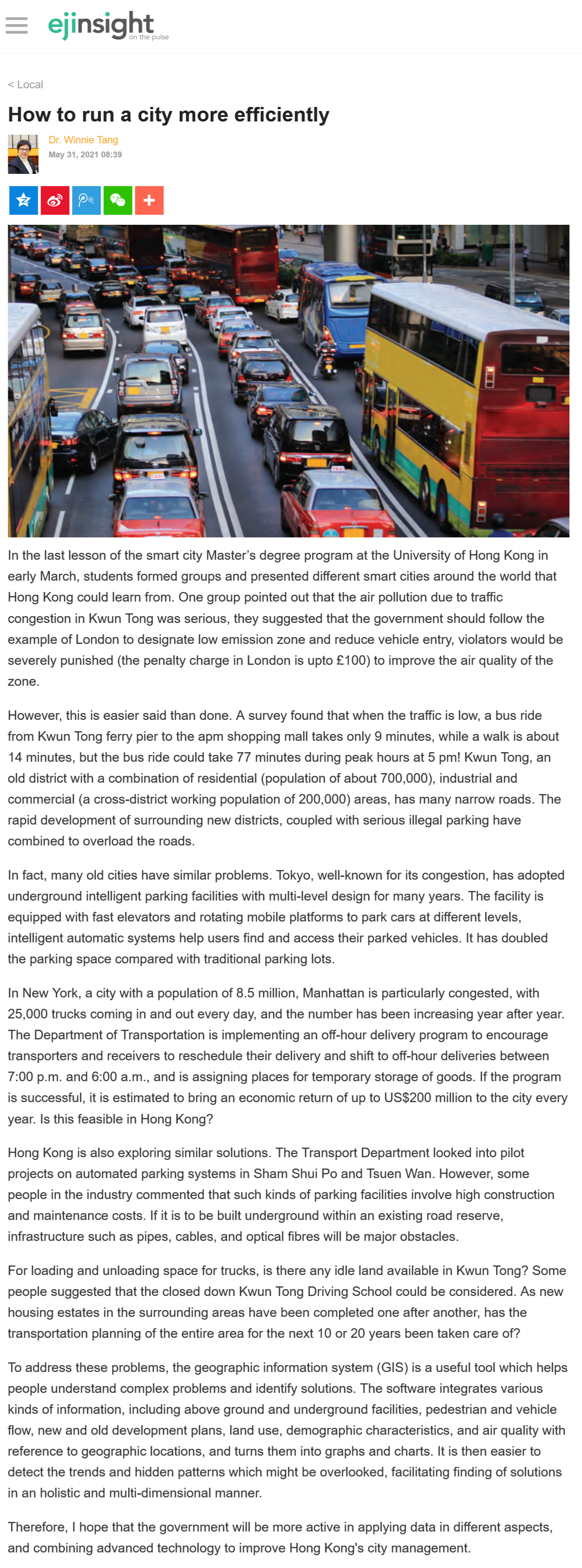網上版請按此

How to run a city more efficiently
In the last lesson of the smart city Master's degree program at the University of Hong Kong in early March, students formed groups and presented different smart cities around the world that Hong Kong could learn from. One group pointed out that the air pollution due to traffic congestion in Kwun Tong was serious, they suggested that the government should follow the example of London to designate low emission zone and reduce vehicle entry, violators would be severely punished (the penalty charge in London is upto £100) to improve the air quality of the zone.
However, this is easier said than done. A survey found that when the traffic is low, a bus ride from Kwun Tong ferry pier to the apm shopping mall takes only 9 minutes, while a walk is about 14 minutes, but the bus ride could take 77 minutes during peak hours at 5 pm! Kwun Tong, an old district with a combination of residential (population of about 700,000), industrial and commercial (a cross-district working population of 200,000) areas, has many narrow roads. The rapid development of surrounding new districts, coupled with serious illegal parking have combined to overload the roads.
In fact, many old cities have similar problems. Tokyo, well-known for its congestion, has adopted underground intelligent parking facilities with multi-level design for many years. The facility is equipped with fast elevators and rotating mobile platforms to park cars at different levels, intelligent automatic systems help users find and access their parked vehicles. It has doubled the parking space compared with traditional parking lots.
In New York, a city with a population of 8.5 million, Manhattan is particularly congested, with 25,000 trucks coming in and out every day, and the number has been increasing year after year. The Department of Transportation is implementing an off-hour delivery program to encourage transporters and receivers to reschedule their delivery and shift to off-hour deliveries between 7:00 p.m. and 6:00 a.m., and is assigning places for temporary storage of goods. If the program is successful, it is estimated to bring an economic return of up to US$200 million to the city every year. Is this feasible in Hong Kong?
Hong Kong is also exploring similar solutions. The Transport Department looked into pilot projects on automated parking systems in Sham Shui Po and Tsuen Wan. However, some people in the industry commented that such kinds of parking facilities involve high construction and maintenance costs. If it is to be built underground within an existing road reserve, infrastructure such as pipes, cables, and optical fibres will be major obstacles.
For loading and unloading space for trucks, is there any idle land available in Kwun Tong? Some people suggested that the closed down Kwun Tong Driving School could be considered. As new housing estates in the surrounding areas have been completed one after another, has the transportation planning of the entire area for the next 10 or 20 years been taken care of?
To address these problems, the geographic information system (GIS) is a useful tool which helps people understand complex problems and identify solutions. The software integrates various kinds of information, including above ground and underground facilities, pedestrian and vehicle flow, new and old development plans, land use, demographic characteristics, and air quality with reference to geographic locations, and turns them into graphs and charts. It is then easier to detect the trends and hidden patterns which might be overlooked, facilitating finding of solutions in an holistic and multi-dimensional manner.
Therefore, I hope that the government will be more active in applying data in different aspects, and combining advanced technology to improve Hong Kong's city management.
Dr. Winnie Tang
Adjunct Professor, Department of Computer Science, Faculty of Engineering; Department of Geography, Faculty of Social Sciences; and Faculty of Architecture, The University of Hong Kong